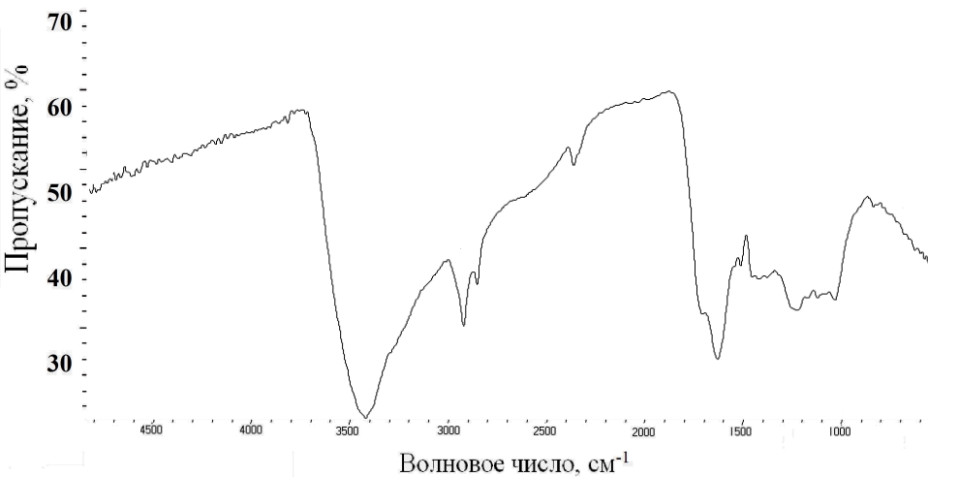BIOLOGICAL ACTIVITY OF HUMIC SUBSTANCES SAPROPEL UPA RIVER TULA REGION
Abstract
The influence of natural polymers – humic substances (HS) from sapropel of the river Upa of the Tula region on the growth and development of the grade of F1 tomato Gina of agricultural company "Aelita", was considered in this paper. The content of the main functional groups (carboxyl, phenolic and quinoid), that define the biological effect of HS were quantitative determined in the composition of HS. Saturation of quinoid groups that possess redox properties and are "trapped" active radical and affect on the operation of antioxidant defense system in plants cells was proved. Stimulating effect of the analyzed humic preparations on the growth of the experimental plants was detected:increase of the total biomass and biometric data (length and width of the sheet, the height of the plants), elevation of amounts of the photosynthetic pigments, proteins and ascorbic acid. Plants that have been treated as fertilizing by humic substances from sapropel were distinguished by high content of photosynthetic pigments such as chlorophyll a, chlorophyll b, and carotenoids (58–69%), ascorbic acid (104%) and protein (60%) compared with control group. Humic substances contain the entire set of organic and inorganic substances required for the cultivation of tomato plants.
Downloads
Metrics
References
Орлов Д.С., Садовникова Л.К., Суханова Н.И. Химия почв : учебник. М., 2005. 558 с.
Перминова И.В., Калмыков С.Н., Карпюк Е.А. Получение алкоксисилильного производного гуминовых ве-ществ для сорбции NP (V) и PU (V) // Вопросы атомной науки и техники. Серия: Материаловедение и новые материалы. 2013. №1. С. 148–158.
Dmitrieva E., Efimova E., Siundiukova K., Perelomov L. Surface properties of humic acids from peat and sapropel of increasing transformation // Environmental Chemistry Letters. 2015. Vol. 13. N2. Pp. 197–202.
Guetzloff T.F., Rice J.A. Does humic acid form a micelle? // Science of the total environment. 1994. Vol. 152. N1. Pp. 31–35.
Terashima M., Fukushima M., Tanaka S. Influence of pH on the surface activity of humic acid: micelle-like aggregate formation and interfacial adsorption // Colloids and Surfaces A: Physicochemical and Engineering Aspects. 2004. Vol. 247. N1. Pp. 77–83.
Perminova I.V., Hatfield K. Remediation chemistry of humic substances: theory and implications for technology // Use of humic substances to remediate polluted environments: from theory to practice. Springer Netherlands, 2005. Pp. 3–36.
Perminova I.V., Kovalevsky D.V., Yashchenko N.Yu, Danchenko N.N., Kudryavtsev A.V., Zhilin D.M., Kuli-kova N.A., Lebedeva G.F., Petrosyan V.S. Humic substances as natural detoxicants // Humic substances and organic matter in soil and water environments: characterization, transformations and interactions. Eds. CE Clapp., MHB Hayes, N. Senesi, S.M. Griffith. 1996. Pp. 399–406.
Борисенко В.В., Хусид С.Б., Лысенко Ю.А., Фолиянц Б.В. Биологическая активность гуминового комплекса различного происхождения и его влияние на рост и развитие растений // Политематический сетевой электронный научный журнал Кубанского государственного аграрного университета. 2015. №110. C. 1167–1177.
Перминова И.В. Гуминовые вещества – вызов химикам XXI века // Химия и жизнь. 2008. Т. 1. С. 50–55.
Дмитриева Е.Д., Горячева А.А., Переломов Л.В., Сюндюкова К.В., Леонтьева М.М. Сорбционная способность гуминовых веществ торфов различного происхождения Тульской области по отношению к ионам Pb(II) // Изве-стия Тульского государственного университета. Естественные науки. 2015. №4. С. 205–219.
Felbeck G.T. Structural chemistry of soil humic substances // Advances in Agronomy. 1965. Vol. 17. Pp. 327–368.
Lichtenthaler H.K., Wellburn A.R. Determinations of total carotenoids and chlorophylls a and b of leaf extracts in differ-ent solvents // Biochemical Society Transactions. 1983. Vol. 11. N5. Pp. 591–592.
Гавриленко В.Ф., Жигалова Т.В., Ермаков И.П. Большой практикум по фотосинтезу. М., 2003. 256 с.
Ballentine R. Determination of ascorbic acid in citrus fruit juices // Industrial & Engineering Chemistry Analytical Edi-tion. 1941. Vol. 13. N2. Pp. 89–89.
Ермаков А.И., Арасимович В.В., Смирнова-Иконникова М.И., Ярош Н.П., Луковникова Г.А. Методы биохи-мического исследования растений. Л., 1972. С. 88–92.
Kruger N.J. The Bradford method for protein quantitation // The protein protocols handbook. 2009. Pp. 17–24.
Жилин Д.М., Перминова И.В., Петросян В.С. Исследование взаимодействия гумусовых кислот со ртутью (II) // Экологическая химия. 1996. Т. 5. №2. С. 131–137.


This work is licensed under a Creative Commons Attribution 4.0 International License.
The authors, which are published in this journal, agree to the following conditions:
1. Authors retain the copyright to the work and transfer to the journal the right of the first publication along with the work, at the same time licensing it under the terms of the Creative Commons Attribution License, which allows others to distribute this work with the obligatory indication of the authorship of this work and a link to the original publication in this journal .
2. The authors retain the right to enter into separate, additional contractual agreements for the non-exclusive distribution of the version of the work published by this journal (for example, to place it in the university depository or to publish it in a book), with reference to the original publication in this journal.
3. Authors are allowed to post their work on the Internet (for example, in a university repository or on their personal website) before and during the review process of this journal, as this may lead to a productive discussion, as well as more links to this published work.











